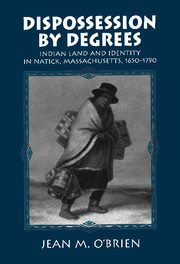Book contents
- Frontmatter
- Contents
- List of illustrations
- Acknowledgments
- Prologue: “My land”: Natick and the narrative of Indian extinction
- 1 Peoples, land, and social order
- 2 The sinews and the flesh: Natick comes together, 1650–75
- 3 “Friend Indians”: Negotiating colonial rules, 1676–1700
- 4 Divided in their desires, 1700–40
- 5 Interlude: the proprietary families
- 6 “They are so frequently shifting their place of residence”: Natick Indians, 1741–90
- Conclusion
- Index
3 - “Friend Indians”: Negotiating colonial rules, 1676–1700
Published online by Cambridge University Press: 04 August 2010
- Frontmatter
- Contents
- List of illustrations
- Acknowledgments
- Prologue: “My land”: Natick and the narrative of Indian extinction
- 1 Peoples, land, and social order
- 2 The sinews and the flesh: Natick comes together, 1650–75
- 3 “Friend Indians”: Negotiating colonial rules, 1676–1700
- 4 Divided in their desires, 1700–40
- 5 Interlude: the proprietary families
- 6 “They are so frequently shifting their place of residence”: Natick Indians, 1741–90
- Conclusion
- Index
Summary
[B]e more carefull for future that no spoyle or wrong be … don to any of our freind Indians, let none of yours come nere to Naticke, Puncapauge, Hassanamesit, or Waymesit, nor among any of our tounes where our freind Indians are … there are other Indians for you to fall vpon, whose pursuing & destroying wee shall take kindly from your hand.
Friends and enemies: bounding peoples
In issuing this directive to Mohawk leaders in 1677, colonial magistrates used a special language for thinking about the position of Praying Indians in the aftermath of King Philip's War. Having recruited Mohawks to bring an end to the Native resistance that continued in northern New England, English officials unwittingly exposed Praying Indians to Mohawk raids. The most devastating loss resulted in the capture of twenty-two Indians from a cornfield at Magunkaquog near Natick in 1678. Mohawk leaders attempted to disassociate themselves from the incident, but also argued: “ye Indians of Magoncog are not ye lesse to blame, they not dwelling as frind Indians in ye Woods, haveing a Castell so well fortifyed wth stockadoes, which frind Indians need not have, Therefore did Imagine them to be Enemyes.” The Mohawk explanation was almost certainly disingenuous, given that their raids against Praying Indians had begun at least as early as the 1660s. But the English and Mohawk agreed in principle that a distinction should be made between “frind Indians” and “Enemyes.” Their negotiations centered on the problem of how to tell the difference between the two.
- Type
- Chapter
- Information
- Dispossession by DegreesIndian Land and Identity in Natick, Massachusetts, 1650–1790, pp. 65 - 90Publisher: Cambridge University PressPrint publication year: 1997



